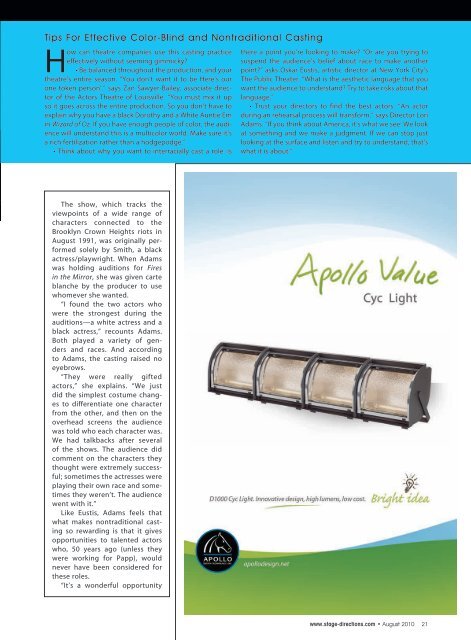Download a PDF - Stage Directions Magazine
Download a PDF - Stage Directions Magazine
Download a PDF - Stage Directions Magazine
Create successful ePaper yourself
Turn your PDF publications into a flip-book with our unique Google optimized e-Paper software.
Tips For Effective Color-Blind and Nontraditional Casting<br />
How can theatre companies use this casting practice<br />
effectively without seeming gimmicky?<br />
• Be balanced throughout the production, and your<br />
theatre’s entire season. “You don’t want it to be Here’s our<br />
one token person',” says Zan Sawyer-Bailey, associate director<br />
of the Actors Theatre of Louisville. “You must mix it up<br />
so it goes across the entire production. So you don’t have to<br />
explain why you have a black Dorothy and a White Auntie Em<br />
in Wizard of Oz. If you have enough people of color, the audience<br />
will understand this is a multicolor world. Make sure it’s<br />
a rich fertilization rather than a hodgepodge.”<br />
• Think about why you want to interracially cast a role. Is<br />
there a point you’re looking to make? “Or are you trying to<br />
suspend the audience’s belief about race to make another<br />
point?” asks Oskar Eustis, artistic director at New York City’s<br />
The Public Theater. “What is the aesthetic language that you<br />
want the audience to understand? Try to take risks about that<br />
language.”<br />
• Trust your directors to find the best actors. “An actor<br />
during an rehearsal process will transform,” says Director Lori<br />
Adams. “If you think about America, it’s what we see: We look<br />
at something and we make a judgment. If we can stop just<br />
looking at the surface and listen and try to understand, that’s<br />
what it is about.”<br />
The show, which tracks the<br />
viewpoints of a wide range of<br />
characters connected to the<br />
Brooklyn Crown Heights riots in<br />
August 1991, was originally performed<br />
solely by Smith, a black<br />
actress/playwright. When Adams<br />
was holding auditions for Fires<br />
in the Mirror, she was given carte<br />
blanche by the producer to use<br />
whomever she wanted.<br />
“I found the two actors who<br />
were the strongest during the<br />
auditions—a white actress and a<br />
black actress,” recounts Adams.<br />
Both played a variety of genders<br />
and races. And according<br />
to Adams, the casting raised no<br />
eyebrows.<br />
“They were really gifted<br />
actors,” she explains. “We just<br />
did the simplest costume changes<br />
to differentiate one character<br />
from the other, and then on the<br />
overhead screens the audience<br />
was told who each character was.<br />
We had talkbacks after several<br />
of the shows. The audience did<br />
comment on the characters they<br />
thought were extremely successful;<br />
sometimes the actresses were<br />
playing their own race and sometimes<br />
they weren’t. The audience<br />
went with it.”<br />
Like Eustis, Adams feels that<br />
what makes nontraditional casting<br />
so rewarding is that it gives<br />
opportunities to talented actors<br />
who, 50 years ago (unless they<br />
were working for Papp), would<br />
never have been considered for<br />
these roles.<br />
“It’s a wonderful opportunity<br />
www.stage-directions.com • August 2010 21

















